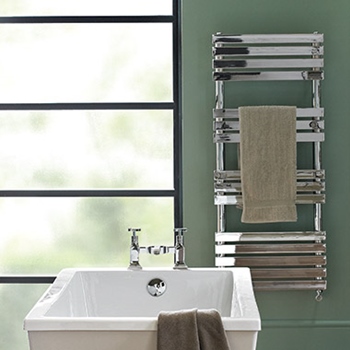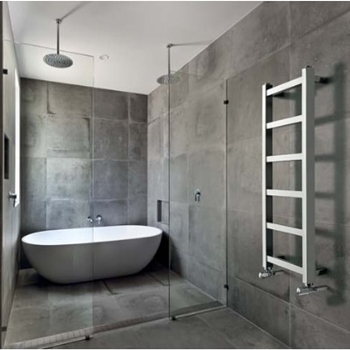There is nothing cozier than taking a hot steaming shower in the middle of the winter. If your bathroom is equipped with a bathroom heater of some sort, it is hard to resist the urge to stay there forever. You can heat up your bathroom through various solutions, and truth be told – sometimes these solutions are already installed.
But are there other benefits of heated bathroom rail? In the next following sections, we are going to talk about thermodynamics in the bathroom, and I promise you I won’t get nerdy or technical. A warm bathroom is a happy bathroom. It helps us relax during long and cold winter nights. Besides, having a system to heat up the whole bathroom can help you fight humidity that leads to all sorts of integral structural damage. Let’s jump right into it!
What Is a Heated Bathroom Rail?
 Heated towel rails, also known as towel warmers, are considered an essential part of a standard home in the western world. However, due to their convenience and multiple functionalities, heated bathrooms rails started gaining traction around the globe. Technically speaking, for small and medium-sized bathrooms, having a heated bathroom rail installed comes with no downsides. All bathrooms are alike, but no two bathrooms are the same, and there lie the nuances of heated bathroom rails.
Heated towel rails, also known as towel warmers, are considered an essential part of a standard home in the western world. However, due to their convenience and multiple functionalities, heated bathrooms rails started gaining traction around the globe. Technically speaking, for small and medium-sized bathrooms, having a heated bathroom rail installed comes with no downsides. All bathrooms are alike, but no two bathrooms are the same, and there lie the nuances of heated bathroom rails.
If you planned on installing a bathroom rail, you’ve certainly had some previous experience with it. Here are the basics of the heated rail anatomy. No matter the type of rail you opt for, every model will have some sort of mounting system. Most popular models used around the world are wall-mounted, meaning that they do not occupy any floor space. This is a great feature if you plan on drying smaller pieces of clothing on the rail, as well as heating the towels.
Now, the rail grid essentially consists of a pipe system, the liquid inside, a heater, and a control mechanism of some sort. Higher-end electric heated bathroom rails even have an adjustable thermostat that offers a wide range of temperatures.
Once the liquid inside is heated up, the pipe grid distributes the heat all over the rails. Of course, due to the nature of metal material, there will be some cold spots – but with modern technology, these spots are hindering the rail’s ability to heat up.
However, depending on the type of heated rail, you can expect different results that also depend on the season and the overall space of the bathroom.
Types of Heated Towel Rails
When it comes to the “fuel source” of heated bathroom rails, two main types stand out – electric and plumbed. Both come with distinguishing benefits and heating capabilities.
1. Electric
Electric heated bathroom rails are simple in design. They usually come as wall-mounted appliances, but there are also freestanding ones out there. Depending on the logistics and space around your bathroom, a freestanding electric heated rail can be a more convenient choice simply because it is portable.
Inside the electric heated rail, there is a liquid mix that is designed to transfer heat evenly to each and every rail, all while not losing a lot of heat. Although there are other standards, the liquid inside is a mix of 85% water and 15% anti-corrosion agents. After all, it is a water-on-metal contact, and you want your heater to last.
The advantage of electric heated rails is that you get to choose when to turn it on or off. So, during the summer, or hot days in general, you don’t have to think about all that heat in the bathroom. Also, more expensive models have a thermostat with a range of heat, which is not the case with the plumbed models. Which brings us to our next point.
2. Plumbed
Plumbed heated bathroom rails, as the name suggests, are connected to the central heating system of your home. Plumbed rail models do not come in portable versions, as the pipes have to be firmly connected from the central heating unit to the rail itself.
The upside of using a plumbed heated rail is not having to think about whether you turned it off before you went on vacation, if you know what I mean. Also, there is no additional need for electricity, because there are no cables in plumbed models. Not to mention that you won’t need to provide a free socket nearby to power the rail.
However, installing a plumbed heated rail is a tad more complicated than installing an electric one. All in all, you will need a professional to do it if the plumbing is not your forte. Also, you will not get to choose the temperature directly from your bathroom. Instead, the rail will heat up according to the thermostat down below, located on your central heating unit.
Will a heated bathroom rail be enough to heat the bathroom?
So, besides having a rail to heat and dry towels and small pieces of clothing, a heated bathroom rail is also, well, a heater. While it is not a big heating unit, per se, it is always positioned in an ideal place inside the bathroom.
So, to answer the question – heated bathroom rails are able to heat up small bathrooms with ease. Not only will it help with keeping the bathroom warm, but you will also sometimes get too hot (if there is such a thing after a shower). Anyway, if your home has a small bathroom, you probably won’t have to install any additional heating units.
But people that have spacious bathrooms might have a different experience. Also, it all depends on the size of the heated rail, as well as its position, and of course – the season. If your area gets freezing cold winters, a heated bathroom rail won’t be enough to keep the bathroom heated. It will, however, heat up the towels and help you dry some clothes efficiently.
If the rail isn’t enough to keep the bathroom warm, well, you should invest in some sort of heater to help you with the issue during the cold winter months. Bigger bathrooms require either a bigger heated rail model, an additional bathroom heating unit or both.
Lastly, you should also check up on the insulation of the bathroom itself. If there is draft air all around, no heating unit will save you from freezing during the colder winter months. Investing in insulation is no cheap task, but it pays off multifold down the road.
Can heated towel rails be left on overnight?
No matter the type (plumbed, electric, or dual-fuel), a heated bathroom rail is perfectly safe for overnight operation. The chances of something bad happening while you are asleep (or away) are slim to none. Some people simply like to have a nice and warm bathroom available as soon as they wake up, ready for that eye-opening morning shower.
Buy, do not forget that heated bathroom rails need a significant amount of power to work, especially overnight. This goes double for electric models that draw power directly from the house grid to convert it into heat.
My advice would be to leave the heated bathroom rail turned on overnight only if it is absolutely necessary. Otherwise, expect a higher electricity or gas bill, depending on the type you opted for.
Are heated bathroom rails as hot as radiators?
 It is a common misconception that a heated rail can reach the temperatures that a radiator can. Most models, when fully heated, reach a temperature of 145° F to 154° F, which is safe to touch, and just enough to help you dry and heat the towels.
It is a common misconception that a heated rail can reach the temperatures that a radiator can. Most models, when fully heated, reach a temperature of 145° F to 154° F, which is safe to touch, and just enough to help you dry and heat the towels.
Even though they utilize similar principles, heated rails and radiators work at different temperatures. Also, radiators often work under pressure that helps with reaching higher temperatures.
There are some high-end plumbed heated bathroom rail systems that can withstand more pressure coming from the central heating unit. These hybrid units require special plumbing skills and experience to install it properly. But if the insulation in your bathroom allows for a lot of heat exchange, even the most expensive models won’t help you heat up the bathroom.
Wrap Up
Heated bathrooms are no longer a commodity. All sorts of systems exist around the globe, but they all have one thing in common – they help you get accustomed to the room temperature outside easier. Jumping from a hot steamy shower into a cold bathroom is an awful feeling, besides being unhealthy. So, to avoid temperature shock, you should consider installing some sort of bathroom heating in your own home.
I hope this little article finds you well and helps you grasp the concept of heated bathroom rails, bathroom heaters, and the essence of having a warm and cozy bathroom in your home. No longer do you have to freeze the moment after you get out of the shower. I mean, the shock can help you wake up, but it set a nervous tone for the rest of the day. Enjoy your baths and showers!